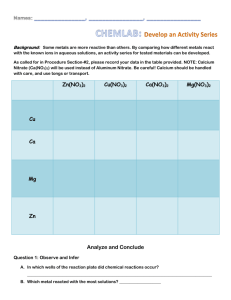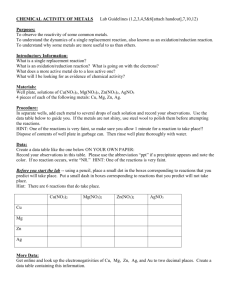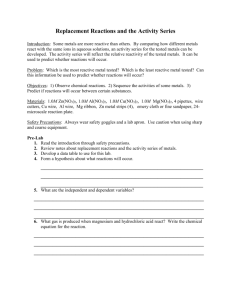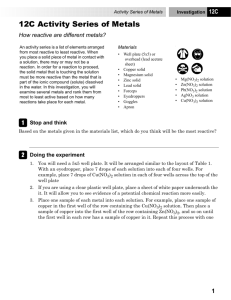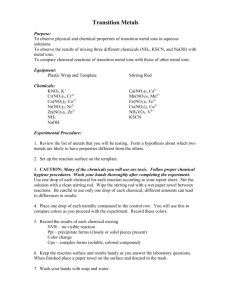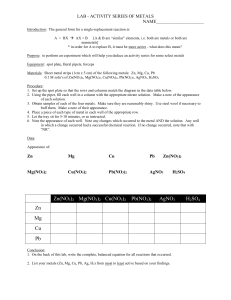Chemical Activity of Metals Lab: Single Replacement Reactions
advertisement
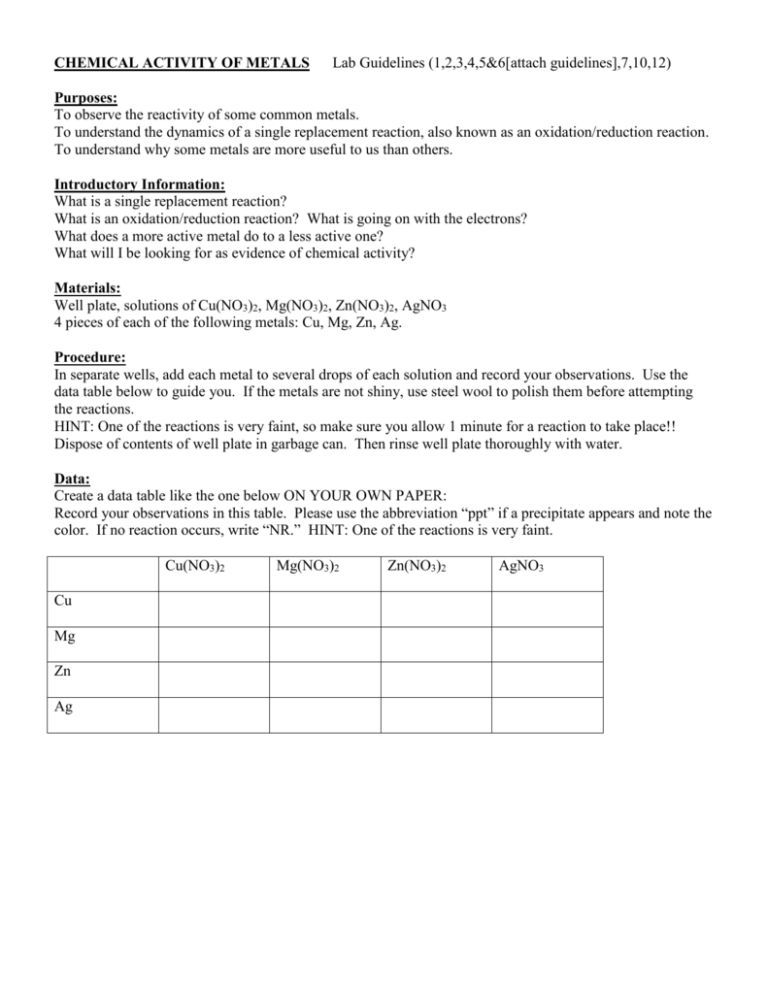
CHEMICAL ACTIVITY OF METALS Lab Guidelines (1,2,3,4,5&6[attach guidelines],7,10,12) Purposes: To observe the reactivity of some common metals. To understand the dynamics of a single replacement reaction, also known as an oxidation/reduction reaction. To understand why some metals are more useful to us than others. Introductory Information: What is a single replacement reaction? What is an oxidation/reduction reaction? What is going on with the electrons? What does a more active metal do to a less active one? What will I be looking for as evidence of chemical activity? Materials: Well plate, solutions of Cu(NO3)2, Mg(NO3)2, Zn(NO3)2, AgNO3 4 pieces of each of the following metals: Cu, Mg, Zn, Ag. Procedure: In separate wells, add each metal to several drops of each solution and record your observations. Use the data table below to guide you. If the metals are not shiny, use steel wool to polish them before attempting the reactions. HINT: One of the reactions is very faint, so make sure you allow 1 minute for a reaction to take place!! Dispose of contents of well plate in garbage can. Then rinse well plate thoroughly with water. Data: Create a data table like the one below ON YOUR OWN PAPER: Record your observations in this table. Please use the abbreviation “ppt” if a precipitate appears and note the color. If no reaction occurs, write “NR.” HINT: One of the reactions is very faint. Cu(NO3)2 Cu Mg Zn Ag Mg(NO3)2 Zn(NO3)2 AgNO3 Questions: Answer the following questions using complete sentences. 1) Which of the four metals reacted with the greatest number of solutions? 2) Which of the four metals reacted with the least number of solutions? 3) List the metals from MOST active to LEAST active. 4) Write the single replacement reaction for Zn reacting with Cu(NO3)2. In this reaction, which metal is losing electrons? Which metal is gaining electrons? Which metal was oxidized? Which metal was reduced? What is the identity of the “ppt” which appeared in the well plate? 5) The Statue of Liberty is made of copper. Use your investigation results to explain why copper is a better material for the statue than magnesium or zinc. Why would silver have been a better choice than copper? Why wasn’t silver used? 6) Gold does not react with any of the solutions in this investigation – not even the AgNO3 solution. What does this tell you about gold’s chemical activity as compared to silver’s chemical activity. Where would gold appear in your list from #3. 7) How does the chemical activity of gold account for it’s use in jewelry and dentistry. 8) Explain why both of the following statements are true even though they sound contradictory: According to everyone other than chemists, gold is an excellent metal. According to a chemist, gold is a poor metal. 9) Lead is less active than zinc, but more active than copper. Predict the results if lead metal is placed in separate solutions of Zn(NO3)2 and Cu(NO3)2. Make a table like the one below and fill it in appropriately with “ppt forms” or “NR.” Zn(NO3)2 Cu(NO3)2 Pb 10) To sum up, complete the following statement: Metals which are active have low __________________ ____________, and therefore can _______ ______________ quite easily to ions of less active metals. Conclusion: Write a conclusion: Here is a great guide for writing your conclusion to this lab: 1) Restate the purpose 2) Summarize the procedure and data collection 3) Discuss any important principles used/learned 4) Report your results
